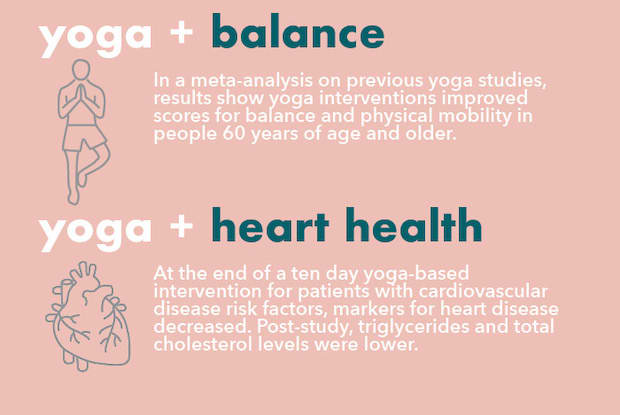Table of Contents
I. How Yoga Can Relieve Stress, Reduce Pain, Improve Balance, and Boost Heart Health
IV. Yoga Can Improve Balance and Mobility
V. Yoga May Support Cardiovascular Health
VI. The Health Benefits of Yoga as a Motivator
How Yoga Can Relieve Stress, Reduce Pain, Improve Balance, and Boost Heart Health
Are you stressed? Do you experience lower back pain from sitting all day? Are your hips and hamstrings feeling tight? Do you want to improve your heart health? Why not give yoga a try. You have nothing to lose.
Yoga is an ancient practice originating from India. The purpose of yoga was to promote spiritual development and create an awareness of one's mind. As yoga philosophy made its way from East to West, our understanding of what yoga is has changed.
Our modern understanding of yoga is the image of a group of students moving through a sequence of yoga poses (also called yoga asanas), usually in a studio setting, and guided by a yoga instructor. But this is a very narrow understanding of what yoga is.
The purposes of yoga were to "cultivate discernment, awareness, self-regulation and higher consciousness in the individual." [1] Yoga has a myriad of health benefits, whether you are a new or experienced practitioner. Read below for some ideas about how yoga is good for you.
Yoga May Reduce Stress

If you've ever taken a yoga class, you will relate to the calm feeling you experience at the end of the session. There is a scientific explanation for this calm feeling and how yoga can help to reduce stress.
Hypercortisolemia is a condition where there is an increased level of cortisol in the body as a result of imbalances in the hypothalamic-pituitary-adrenal (HPA) axis. The HPA axis includes the hypothalamus (located in the brain), the pituitary gland (located at the base of the brain), and the adrenal glands (located on top of the kidneys). [2]
The "stress" hormone is also known as cortisol. When we are under too much stress, our immune system becomes compromised — we may be more susceptible to bacterial, fungal, and parasitic infections. [3]
But how are stress, cortisol, and yoga, related?
There is a wide range of evidence suggesting that yoga can help decrease stress. One study looked at the impact that yoga can have on total cortisol levels in the body. This study also aimed to understand if yoga could help to relieve symptoms of depression.
The findings support that yoga promotes "anti-stress" effects by acting on the hypothalamus to reduce cortisol. The implementation of yoga and decrease in cortisol levels helped to bring about relief in depression. The study summarized that yoga had a significant influence on cortisol response. Furthermore, yoga may also be indicated to have antidepressant effects. [4]
Yoga May Reduce Pain

One study recruited 22 participants with Fibromyalgia (FM) to take part in two 75 minute yoga classes weekly for 8 weeks. Questionnaires about pain — measuring things like intensity, unpleasantness, catastrophizing, acceptance, and disability — were administered pre- and post-intervention. Post-yoga intervention, scores improved for continuous pain, pain catastrophizing, and pain acceptance. So, yoga may contribute to pain reduction. [5]
Chronic back pain, including lower back pain, is a health condition experienced by many individuals. Management of chronic back pain can cost a lot of money and take a long time to heal. These barriers leave the patient discouraged in finding a solution. Yoga is a cost-efficient, safe alternative therapy that may help decrease back pain.
One study used yoga as a treatment alternative. The selected group of patients for this study includes 33 military veterans, with a mean age of 55. They underwent a yoga program as part of their treatment for back pain.
Data collected measures through questionnaires. Measures include: pain, depression, energy/fatigue, health-related quality of life, and program satisfaction. The authors wanted to understand if a consistent yoga practice offered any results. [6]
Their findings show that health scores improved after the yoga intervention. An increase in the frequency of yoga sessions was an important factor. Outcomes for pain, depression, and mental health improved.
The study data suggest a yoga intervention may improve health. It appears that the patients in the study experienced a decrease in back pain as a result.
Yoga Can Improve Balance and Mobility

If you've ever attempted tree pose, you understand that it requires balance. A good amount of flexibility and mobility help in a yoga class, too. Often we seek out yoga for these very reasons: to improve our balance, mobility, and well being.
As we age, balance and mobility are essential. They help us to manage independence and improve our quality of life. One such study analyzed six previous clinical trials whereby yoga interventions were implemented. The study looked at 300 participants aged 60 and over. It indicated that balance and mobility improved with the implementation of yoga-based exercises.
The types of yoga offered in these interventions included Hatha yoga and Iyengar yoga. The seated movements in these classes included seated and standing poses. Some of the seated poses include reclined twist, reclined hamstring stretch, pigeon, and cat-cow. Strengthening standing postures include mountain pose, chair, warrior one, and half-moon. [7]
The kinds of poses mentioned above are found in most standard yoga classes at a studio near you. Yoga benefits the balance and mobility of the elderly generation. But it may provide benefits to anyone who decides to practice yoga, no matter what age.
It was also noted that improved balance from yoga could prevent falls as we age. As we prevent falls, we reduced our risk for injuries as we get older. This is an important finding. One-third of adults aged 65 and over have been shown to fall at least once per year.[8][9]
Yoga May Support Cardiovascular Health

It is more common nowadays for yoga to be considered as a safe intervention for chronic pain. Yoga may also be indicated as helpful in disease prevention and health promotion. Hearth health is an important contributor to our quality of life and longevity. Yoga can help reduce anxiety, improve quality of life, and promote well-being. Yoga has also shown to be useful for patients with heart disease and hypertension. [10]
One study looked at the short-term impact of a yoga-based intervention for participants with indicators of risk for cardiovascular disease. The study was ten days in length and included 98 subjects, with ages ranging between 20-74 years. The subjects all had a variety of illnesses such as coronary artery disease, hypertension, diabetes mellitus, and others.
The intervention, albeit short in length, was comprehensive in its approach. It consisted of postures (asanas), breathing exercises (pranayama), relaxation techniques, meditation, philosophy of yoga, and yoga in daily life, as well as several other aspects.
As a result of yoga intervention, markers for cardiovascular disease decreased, thus having a positive impact on heart health and well-being. The results show that total cholesterol levels and triglycerides were lower on the last day of the course compared to the first day of the course. [11]
A similar study looked at the effects of yoga therapy on cardiovascular endurance and inflammatory markers for medically stable African American heart failure patients. Post-study, patients in the yoga therapy group showed improved cardiovascular endurance and inflammatory markers. The results of this study show how yoga can positively affect cardiovascular health. [12]
In conclusion, stress management and lifestyle changes can have a positive impact on our health. Cardiovascular health may benefit from adding a yoga regime into a daily routine.
The Health Benefits of Yoga as a Motivator
Remember that calm feeling you experienced at the end of your yoga class? Or the interesting facts you learned about yoga interventions from reading scholarly articles? Let these act as a motivator — yoga is a beneficial practice to add to your daily life.
We've covered how yoga helps to reduce and relieve anxiety, and can decrease your body's cortisol levels. Yoga can help to reduce chronic back pain, which is a common ailment that plagues our society. Yoga can help increase our strength when balancing, improve our mobility and flexibility, which helps us to age with grace. Lastly, yoga has the potential to improve heart health and minimize risks associated with cardiovascular disease.
The content in this article is intended for informational purposes only. This website does not provide medical advice. In all circumstances, you should always seek the advice of your physician and/or other qualified health professionals(s) for drug, medical condition, or treatment advice. The content provided on this website is not a substitute for professional medical advice, diagnosis or treatment.
